|
It’s time to look forward to next year and the most important job in september is to order your bulbs. Once they arrive, plant them as soon as possible - with the exception of the tulips, which are not planted out until cooler weather arrives. The reason for this is that it discourages a fungal disease called tulip fire (Botrytis tulipae), which causes grey-green lesions on the leaves and petals. For tulips then, store them somewhere cool and dry, away from mice and squirrels, and plant them anytime from late-October to Christmas, when the soil is frost-free.
Planting Tips

The general rule of thumb is to plant all your bulbs at least twice the depth of the bulb. Wear gloves if you have sensitive skin because some bulbs do irritate the skin (particularly hyacinths), and always wash your hands afterwards as they are often treated with a fungicide.
A small trowel is the most useful tool in the border, but a garden spade is best when planting in grass. Cut a foot-long v-shape in the grass, as if it were two sides of a triangle, and lift the v-shaped flap of turf. Break up the soil underneath with a garden fork and place the bulbs in the triangle and then stretch the flap of turf in your hands to distress it slightly. Replace the turf, trimming if you have to.
If you’re planting a border, avoid any straight lines unless it’s in a cutting garden. Randomly throw them on the ground and plant where they land. This looks far more natural. If it’s a large area and you have a small child, you can copy the famous Miss Ellen Willmott of Warley Place in Essex. She placed the small child in a wheelbarrow with a sack of bulbs and pushed it along whilst they showered the ground with bulbs.
Getting an Early Show
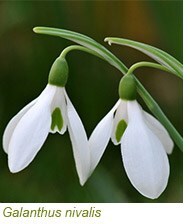 Having early flowers in the garden really lifts the spirits and there are several flowering bulbs that perform in the first weeks of the New Year. Place these where you can see them from the house in a suitably warm and sheltered location. Form small clumps to make a greater impact on the eye, rather than spreading them out. You could use snowdrops and these include the single form of Galanthus nivalis,or the double which is known as ‘Flore Pleno’. Singles open in good light, but doubles always look open even in dull weather - although they aren’t as elegant. For a bolder snowdrop, with wide grey leaves, opt for Galanthus elwesii and you’ll also get boldly marked white single flowers. Add the little known grey-blue Scilla mischtschenkoana, which flowers at snowdrop time, showing up well against bare earth. This will flower in shady positions too. Having early flowers in the garden really lifts the spirits and there are several flowering bulbs that perform in the first weeks of the New Year. Place these where you can see them from the house in a suitably warm and sheltered location. Form small clumps to make a greater impact on the eye, rather than spreading them out. You could use snowdrops and these include the single form of Galanthus nivalis,or the double which is known as ‘Flore Pleno’. Singles open in good light, but doubles always look open even in dull weather - although they aren’t as elegant. For a bolder snowdrop, with wide grey leaves, opt for Galanthus elwesii and you’ll also get boldly marked white single flowers. Add the little known grey-blue Scilla mischtschenkoana, which flowers at snowdrop time, showing up well against bare earth. This will flower in shady positions too.

However most contenders for the ‘Race of the Year’ prefer an open sunny site. The very early Crocus sieberi subsp. sublimis f. tricolor is a jaunty little bulb that’s quite capable of popping through snow. The three-way flowers contain yellow, white and purple and from a distance it appears as a purple egg cup containing a broken egg. Use this en masse round the feet of fruit trees.

Other early arrivals to the springtime ball include Cyclamen coum, another sun lover for an open spot, with jaunty short-stemmed flowers nosed in magenta. The rounded foliage can be silvered, marbled or green and, after flowering purse like seeds pods form. The sticky coating on the seeds is attractive to ants and they distribute the seeds for you as they roll them around for you.
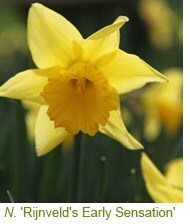 There is one foot-high narcissus that can also flower very early in the year, N. 'Rijnveld's Early Sensation’, and this should be grown in a key position at the corner of a path or by a doorway, so that you can enjoy it. This all-yellow daffodil will return year after year, and it’s well named - sensational and early. There is one foot-high narcissus that can also flower very early in the year, N. 'Rijnveld's Early Sensation’, and this should be grown in a key position at the corner of a path or by a doorway, so that you can enjoy it. This all-yellow daffodil will return year after year, and it’s well named - sensational and early.
The last contender for the ‘Race of the Year’ is the winter aconite, which needs a warm position to open early. It can thrive under deciduous trees, helped into early flower by the benign woody canopy ahead, or it can flower against a warm wall. It’s a great bee favourite and spreads by seeds scattered from star-shaped pods.
Crocus

These are the most bee-pleasing bulb of all, because the goblet of petals traps warm air, and warmth helps nectar flow. Smaller-flowered crocus flower first, usually by February, and among the stars are the purple and white ‘Ladykiller’ and the silver-blue ‘Blue Pearl’. These are best in warm, open sites: they do not like being in grass. Mice can devour the bulbs, so if you have these, protect the bulbs with pieces of chicken of wire, or get a cat and train it up!
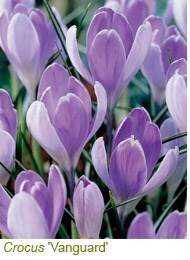 Large crocus, related to the alpine species Crocus vernus, make excellent plants in the border or lawn, and they are not so fussy about drainage. The earliest is a Russian-collected silver and purple called ‘Vanguard’, that flowers two weeks after the smaller ones and two weeks before the larger ones - hence its name. Later ones include the purple and white striped ‘Pickwick’ and the full-flowered ‘Remembrance’. Known as Dutch crocus they are real stalwarts, returning year after year. Large crocus, related to the alpine species Crocus vernus, make excellent plants in the border or lawn, and they are not so fussy about drainage. The earliest is a Russian-collected silver and purple called ‘Vanguard’, that flowers two weeks after the smaller ones and two weeks before the larger ones - hence its name. Later ones include the purple and white striped ‘Pickwick’ and the full-flowered ‘Remembrance’. Known as Dutch crocus they are real stalwarts, returning year after year.
Naturalising in Grass
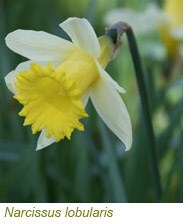 The best narcissi for naturalising in grass are robust, on the short side and simply formed. They include the jaunty ‘Jetfire’, which has an almost red trumpet and yellow outers. Or go natural and plant the native varieties which are N. obvallaris, the Tenby daffodil, an all-yellow affair. The two-tone yellow N. lobularis, the English wild daffodil, also does well in grass once established. Or you could plant an old pre-1869 variety that looks like a wilding, ‘W.P. Milner’. These daffodils tend to spread by setting seeds so plant them in clusters and don’t deadhead them. Do all the others though. The best narcissi for naturalising in grass are robust, on the short side and simply formed. They include the jaunty ‘Jetfire’, which has an almost red trumpet and yellow outers. Or go natural and plant the native varieties which are N. obvallaris, the Tenby daffodil, an all-yellow affair. The two-tone yellow N. lobularis, the English wild daffodil, also does well in grass once established. Or you could plant an old pre-1869 variety that looks like a wilding, ‘W.P. Milner’. These daffodils tend to spread by setting seeds so plant them in clusters and don’t deadhead them. Do all the others though.
Be Adventurous
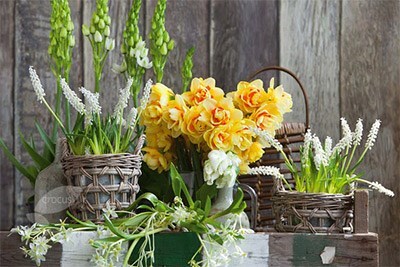
It’s far too easy to keep ordering the same old thing, but it’s really worth experimenting because new bulbs are being released all the time, whilst some of the tried and tested are beginning to break down. The best way to try something new is to grow ten or so in a suitable pot. This will give you the chance to assess foliage and flower and, if you like them, they can then get put into the garden.

A new daffodil called ‘Tete Rosette’, is a Crocus exclusive. It’s a double form of ‘Tête-à-Tête’, the world-famous miniature daffodil. ‘Tete Rosette’ has an inner cup full 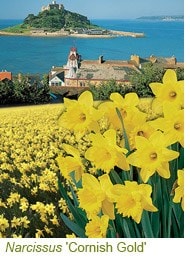 of ruffled petals surrounded by a slightly reflexed collar, giving it a windswept quality. ‘Toto’, another new arrival, is a miniature multi-headed white with a trumpet that fades from yellow to white, so this will look almost translucent in spring sunshine. ‘Cornish Gold’ is taller, a foot at least, with traditional yellow flowers that appear very early. Or try the classic Irish-bred (in 1956) fully double frilly yellow ‘Tahiti’, ribboned in vivid-orange. It’s not new, but not grown nearly often enough. They all show how versatile the daffodil is, from country waif to elegant sophisticate. of ruffled petals surrounded by a slightly reflexed collar, giving it a windswept quality. ‘Toto’, another new arrival, is a miniature multi-headed white with a trumpet that fades from yellow to white, so this will look almost translucent in spring sunshine. ‘Cornish Gold’ is taller, a foot at least, with traditional yellow flowers that appear very early. Or try the classic Irish-bred (in 1956) fully double frilly yellow ‘Tahiti’, ribboned in vivid-orange. It’s not new, but not grown nearly often enough. They all show how versatile the daffodil is, from country waif to elegant sophisticate.
Scented Narcissus
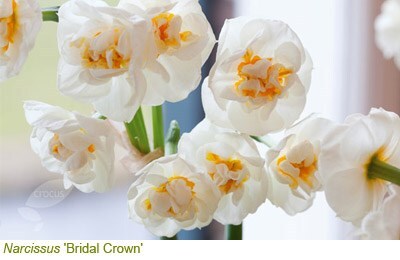
Scented varieties are highly popular whether in vase or the garden. Most scented narcissi tend to flower in April and they have Jonquil blood. The Award winning fragrant multi-headed collection contains three rosette flowered forms. ‘Bridal Crown’ is cream with a hint of orange in the yellow 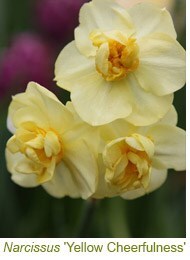 middle, ‘Yellow Cheerfulness’ is a delicate yellow and ‘Winston Churchill’ is a cream with a marmalade twist. Or you could go for the Sweetly scented collection containing amongst others, a very miniature species with pale outers and deep-yellow cup. Narcissus 'Canaliculatus' looks stylish grown in a simple terracotta pot, or at the front of the border. 'Silver Chimes' is a milk-white narcissi with a pale-lemon trumpet and ‘Curlew’, which flowers in late-April after the others, is a cream-white with a pale trumpet that ages to almost white. They’re all good in pots, or in a cutting garden. middle, ‘Yellow Cheerfulness’ is a delicate yellow and ‘Winston Churchill’ is a cream with a marmalade twist. Or you could go for the Sweetly scented collection containing amongst others, a very miniature species with pale outers and deep-yellow cup. Narcissus 'Canaliculatus' looks stylish grown in a simple terracotta pot, or at the front of the border. 'Silver Chimes' is a milk-white narcissi with a pale-lemon trumpet and ‘Curlew’, which flowers in late-April after the others, is a cream-white with a pale trumpet that ages to almost white. They’re all good in pots, or in a cutting garden.
Tulips
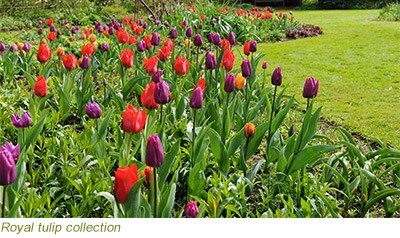
The most useful garden tulips arrive in the second half of April or in May, after most of the daffodils have flowered. For this reason it’s a good idea not to mix the two because by the time your tulips flower, the daffodils will be passed their best. Tulips make a huge difference to any garden because most gardens are burgeoning with new foliage by late-spring but have very few flowers. Tulips plug that gap better than any other plant.

A potful of tulips is a glorious addition because it allows you to put lots of bulbs together by layering them up in a lasagne style arrangement. Once planted, using John Innes Compost if you can, place the pot somewhere cool and dry so that the bulbs do not get deluged. If they do they can rot. Or you can add your tulips to a border. You can either opt for a single variety, which can look minimalist and elegant, or you can mix and blend. Restrict your choices, otherwise your garden may look like a multi-coloured trifle.
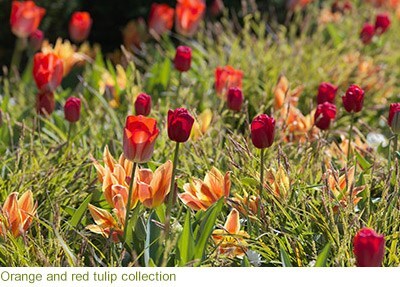
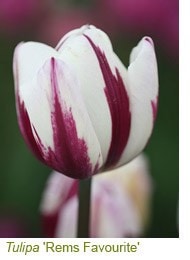 The core of any mixed arrangement should be Triumph tulips, because these highly-bred tulips have sturdy stems, thick petals and come in vibrant colours. These flower in the second half of April, so by adding some May-flowering Tulips ( such as the lily-flowered, single, double late, or fringed types) to the mix, you can have a pot that will last for four weeks. Trim away the faded flowers as they finish. The core of any mixed arrangement should be Triumph tulips, because these highly-bred tulips have sturdy stems, thick petals and come in vibrant colours. These flower in the second half of April, so by adding some May-flowering Tulips ( such as the lily-flowered, single, double late, or fringed types) to the mix, you can have a pot that will last for four weeks. Trim away the faded flowers as they finish.
|
| |
Recommended Tulips for Pots or Borders
Old Faithfuls
‘Ballerina’

This terracotta-orange lily-flowered tulip is also scented. It tones wonderfully well with the coppery tones of freshly emerging new rose foliage.
‘Barcelona’ and
‘Don Quichotte’

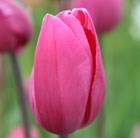
These are both award-winning pink Triumph tulips, Use them with dark, sultry single late tulips such as ‘Paul Scherer’, ‘Queen of Night’ or the double late...
‘Black Hero’
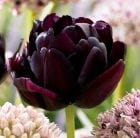
You can also use light-yellow with dark tulips (although leave out the pink) and 'Nicholas Heyek’ (a Triumph) will work well.
‘Orange Princess’
and ‘Prinses Irene’
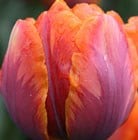
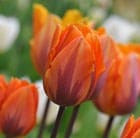
‘Orange Princess’, a sport from the fabulous 'Princess Irene’, are both first rate. They have purple shading on their nasturtium-orange flowers that can highlight dark tulips, or stand alone.
‘Spring Green’
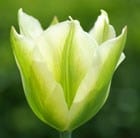
The classic white and green viridiflora tulip with flowers that last for ages and it does return.
‘Curly Sue’
and ‘Swan Wings’
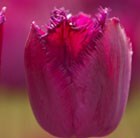
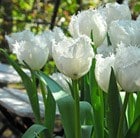
Both fringed tulips, so useful for adding a different texture. ‘Swan Wings’ is a pure white and ‘Curly Sue’ a purple-pink. Lovely when spring sunshine catches the fringed pinking.
Brave New Choices
‘Doll’s Minuet’
and ‘Violet Bird’
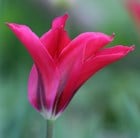
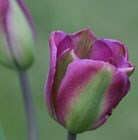
'Doll’s Minuet' is a small bright pink viridiflora tulip that has hardly any green. Perfect for a pot, because it’s almost like a butterfly about to take off. I also like the look of ‘Violet Bird’. Lots of green on the petals indicates a long-lasting flower.
‘La Belle Époque’
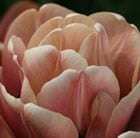
This peony-flowered tulip comes in a soft swirl of apricot and cream, with a drizzle of blueberry, so it’s perfect in a terracotta pot, or on its own, or with a mixture of purple tulips.
‘Victoria’s Secret’
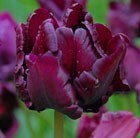
A windblown soft arrangement of purple, perfect for the vase or container.
‘Cairo’
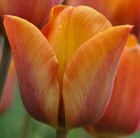
A golden Triumph tulip which can unite red and yellow planting, or dazzle with darks.
‘Fringed Elegance’
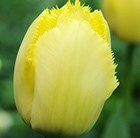
A subtle yellow fringed tulip of great beauty. There are not many good yellows, so this is a blessing.
‘National Velvet’
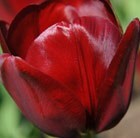
A deep, substantial red and very long lasting in the garden. This one will not disappoint in border or pot.
|








































